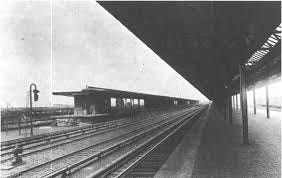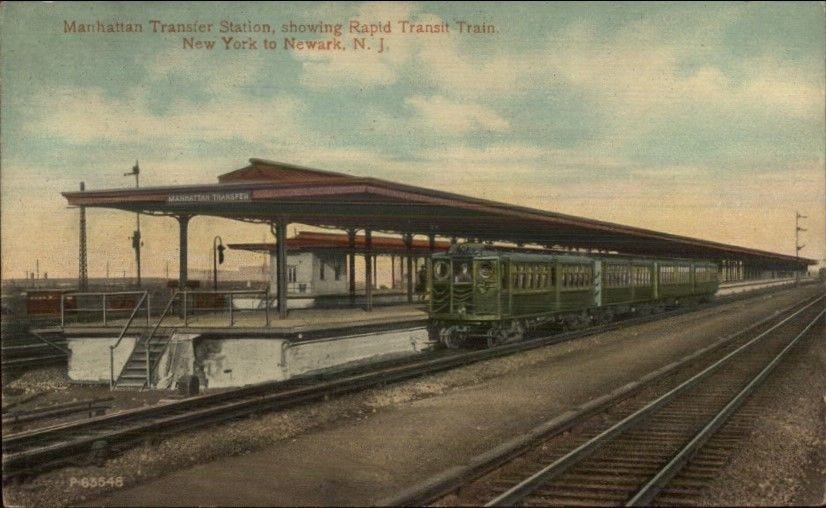This posting originally appeared in New Jeresy Newsroom in 2009
Image: New Yok Transit Forums
Say "Manhattan Transfer" and most folks think of the innovative musical vocal ensemble that sings those jazzy tunes.
Those of a literary bent may recognize Manhattan Transfer as an important work by the early 20th Century American novelist John Dos Passos. Published in 1925, it focused on the urban life of NYC in the Jazz Age as told through a series of individual stories.
Yes, a catchy name ... inspired by the original Manhattan Transfer that existed almost 100 years ago but is now all but forgotten except for a few railroad historians.
And this Manhattan Transfer was not in Manhattan at all — but in New Jersey, just east of Newark in what is now known as the edge of the Meadowlands.
In fact, Manhattan Transfer was a passenger rail station in Harrison on the Pennsylvania Railroad's main line to New York City, now Amtrak's Northeast Corridor. It consisted of two transfer platforms, one on each side of the PRR line.
The original purposes of the station were for changing steam locomotives to electric locomotives on trains bound for Penn Station in midtown Manhattan. It also allowed passengers to transfer between these trains and trains bound for Exchange Place and a ferry connection to lower Manhattan, before the PRR was electrified to Philadelphia. When the Hudson and Manhattan Railroad (later called the Hudson Tubes, and now known as PATH) was opened to Newark, one track was built on each side of the PRR in the area of Manhattan Transfer, and Hudson & Manhattan Railroad trains (H&M) stopped there, giving additional connecting service to lower Manhattan.
The only access to the station was by train; no local access was provided.
The Transfer first opened on November 27, 1910. A New York Times article of the time reported that two minutes after midnight the first train was to leave through the Hudson River tube, the Perth Amboy local, followed at 12:30 by the Southern Express to Baltimore, Washington, and other points south.
The H&M opened to it on October 1, 1911.
In 1933, the Pennsylvania Railroad completed its electrification to Philadelphia and locomotive changes no longer took place at Manhattan Transfer. The Transfer was closed when the H&M was realigned to the new Newark Penn Station on June 20, 1937 (the same day the Newark City Subway was extended to Newark Penn Station); passengers now transfer at Newark.
The Transfer itself was a pair of 1,100 foot high level platforms connected by an underpass and a sky-lighted umbrella once described by a journalist as "coop like." To its north was the three tracked Morris and Essex Line of the Lackawanna Railroad, and to the South the brackish water of the Passaic River. The only vegetation in the area were reeds and marsh of the swamp.
Image: Wikipedia
Books chronicling that era tell of fortune seekers heading to New York and disembarking trains at what was announced by conductors as "Manhattan Transfer," believing that they had arrived in the big city. Instead, they found to their chagrin that they were stuck on a train platform in the midst of a New Jersey swamp without a street or car in site — let alone New York's "streets paved of gold."
Today, the tracks of Amtrak, NJ Transit and PATH still cross the spot, but there is no visible sign of the major transfer station that once occupied the location. These days the Secaucus Transfer serves a similar function up the line a ways (providing a unique connection among modern-day NJ Transit lines). It seems everything old is new again, for the new transfer now named after Senator Frank Lautenberg was initially built primarily as a railroad transfer with limited access to auto traffic (Though this situation has since started to change — A Turnpike exit has been added; a park ride area has been provided and offsite parking is being added).
As for Manhattan Transfer, the musical group is rarely to be seen in Manhattan or New Jersey. You'll have to go a ways as they are now Europe-based. Having recently released a new album, they have been touring Italy, Denmark and Switzerland.
You can still read the Dos Passos book Manhattan Transfer, and for you train buffs, the story about the original Manhattan Transfer is also still available in book form at your local library — Rails under the mighty Hudson: the story of the Hudson Tubes, the Pennsy tunnels, and Manhattan Transfer. Hudson Valley Heritage Series (2nd ed.). Cudahy, Brian J. (2002); New York: Fordham University Press. pp. 41-54. ISBN 0-8232-2189-X.
Image: American-Rails.com






